City of San Francisco Wi-Fi alternatives considered
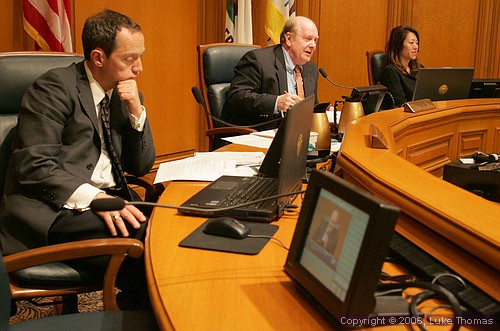
Supervisors Bevan Dufty, Jake McGoldrick and Fiona Ma, at the
City Neighborhood and Services Committe hearing yesterday to discuss
alternative City WI/FI solutions.
Photo(s) by
Luke Thomas
By Aldrich M. Tan
May 1, 2006
The City Operations and Neighborhood Services Committee heard
concerns from various internet providers regarding the proposed
San Francisco municipal wireless fidelity program.
In March, the city awarded the contract for the development of
the city's municipal wireless program to Earthlink and Google.
The intent of Monday's hearing was to discuss alternative digital
infrastructures, including but not limited to existing wireless
networks, copper, cable and fiber.
"It's important that we have this discussion in a public
meeting because public assets will be used in the development
of the program," Supervisor Jake McGoldrick said.
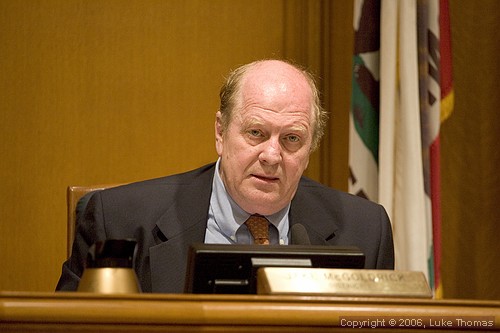
Supervisor Jake McGoldrick sponsored the committee item to examine
alternative solutions to fulfill San Francisco push for city-wide
Wi/Fi.
James Chafee, City Hall gadfly, agreed with McGoldrick.
"Wireless internet today is just as important today as the
horse and buggy was during its time period," Chafee said.
Tim Pozar, Chief Operations Officer for UnitedLayer, a community
wireless network that supplies bandwidth to the city, expressed
concern about being unable to co-exist with the city program and
how it would be challenging for other wireless companies to enter
the city's market.
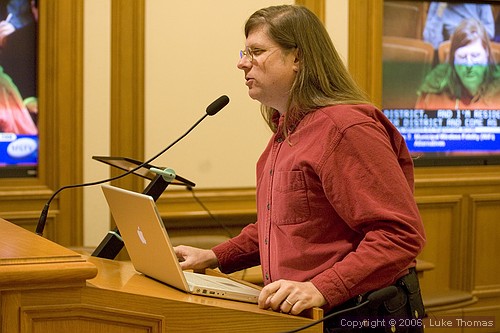
Tim Pozar
A municipal wireless program would be challenging to construct
because the standard wireless technology was not designed to work
with long distances, Pozar said. The wireless frequency, 802.11b,
could interfere with 25 other types of spectrum users, including
radio operators using 100 watt transmitters.
"I can't tell a radio operator to stop running because I
can't connect to the municipal wireless internet," Pozar
said.
Ralf Muehlen, representative of SFLAN, a nonprofit commuity wireless
program in San Francisco, said that the proposed wireless contract
with Earthlink and Google could also have privacy concerns.
"When you are searching for something with the new wi-fi,
they will know who you are and exploit you for advertising,"
Muehlen said.
Bruce Wolfe proposed another alternative to wireless: fiber-optic
lines, a technology that uses glass or plastic threads to transmit
data rather than the traditional metal communications lines.
"Fiber works well and has a lot of growth," Wolfe said.
"It is very reliable with a 99.88 percent upload time and
very fast data services, including voice and video."
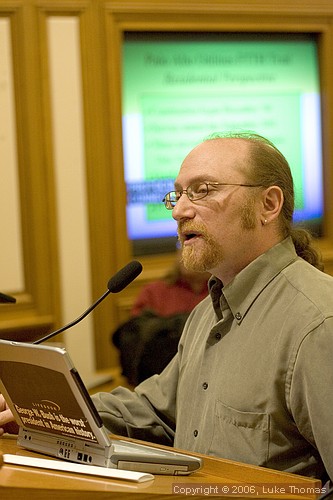
Bruce Wolfe
The technology is already available in the city, Muehlen said.
The Proposition A bond project in 2001 enabled the City College
of San Francisco to create a 23 mile fiber ring through the city
which connects the city college's campuses. An additional 13.5
miles is available through the public safety ring.
Fiber optics projects are taking place in Utah, Amsterdam Japan,
and Palo Alto, Wolfe said.
Access to Palo Alto's fiber optic network is only available mostly
to the city's business community, according to the City of Palo
Alto Utilities' Web site. A customer must "light" the
fiber by adding voice, data or video equipment to the end of their
licensed fibers and transmit information between locations.
Palo Alto initially approved the fiber-to-the-home trial in November
2000 but in mid-December 2005, the City Council terminated the
trial, according to the City of Palo Alto Utilities' Web site.
The Palo Alto City Council recommended for the staff to develop
a request of proposals in terms of any public entities interested
in pursuing the citywide deployment of the fiber-to-the-home trial
this January, according to the CPAU Web site.
Carlos Rios, president of nextWLAN Corporation said the biggest
problem of Earthlink's program is its lack of coverage. The wireless
network's coverage would consist of t-coverage areas.
"That's not free wi-fi for all," Rios said. "That's
free wi-fi for a few."
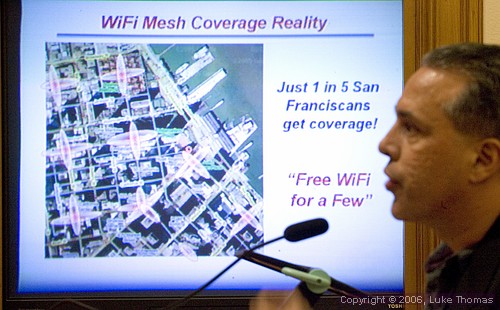
Carlos Rios explains there will be coverage problems
with the Google/Earthlink Wi/Fi proposal.
Rios proposed a city-owned indoor wireless network that would
employ wireless servers called MicroNodes throughout the city
that would connect directly to DSL lines.
The MicroNodes would cost $100 each and the company is expecting
to upgrade its equipment in a year, Rios said.
Ron Vinson, chief administrative officer for the Department of
Telecommunications and Information Services, thanked everyone
who spoke. He said the department will continue to look into the
issues as it discusses its contract with Earthlink.
"We want the best possible deal for everyone in the city,"
Vinson said. "40 percent of our population still does not
have internet connectivity. Wi-fi would be the most efficient
means in order to bring the digital inclusion to a level laying
field."
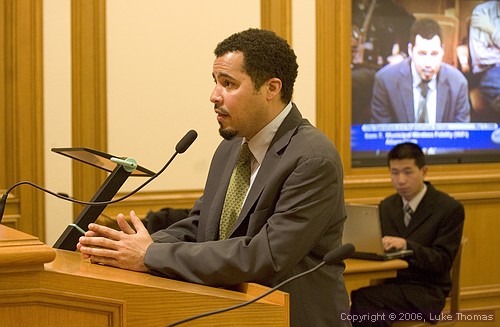
Ron Vinson
The major issue in incorporating the fiber-to-the-home program
is its cost, Vinson said.
"We know from experience that the local cable companies
require at least 900 miles of cable fibers," Vinson said.
"That could cost millions of dollars."
The idea of utilizing the city-owned fiber optic network is still
under consideration, Vinson said. It is a project that will take
several years to put together, based on its economic feasibility.
Andre Chan, a graduate student at UC Berkeley, said it was important
for the city to pursue the wireless project. According to statistics
of the latest U.S. Census Bureau, internet access for local nonwhite
is 56 percent compared to 72 percent of white residents.
"By deploying a wireless network throughout the city, these
people will be helped the most," Chan said.
McGoldrick said the dialogue was productive.
"I think we're on the verge of something major," McGoldrick
said. "I just want to make sure that the Board of Supervisors
is educated enough when we do have to make a decision about this
program."
In October 2004, Mayor Gavin Newsom announced that he intended
to provide free wireless access for the city during his state
of the city address. nextWLAN and SF Metro Connect, comprising
of Seakay, Cisco and IBM, were among the bidders.
In March, the city announced that it selected Google and Earthlink
to build the city's wireless network. Philadelphia and Milpitas,
Calif. also selected Earthlink to developed similar municipal
wireless programs.
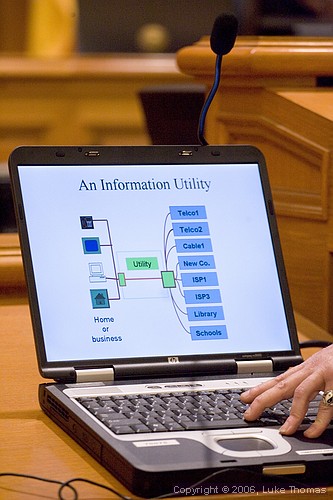
####
|